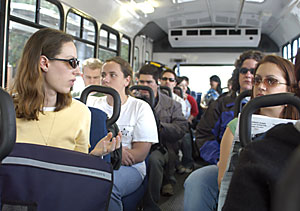 |
|
CLAIRE C. LAURENCE/Arizona Daily Wildcat
|
International studies sophomore Jen Johns takes a ride on the CatTran yesterday afternoon. The City of Tucson held a public forum yesterday concerning developments in campus-area transportation.
|
|
|
By Jennifer Amsler
Arizona Daily Wildcat
Thursday, February 24, 2005
Print this
City officials are working to create a modern mass transportation system that would run through the UA to downtown Tucson, an area they say will soon be a magnet for student living.
Jim Glock, the director of the Tucson Department of Transportation, said an additional 2,000 housing units will pop up downtown in the next four years, making a reliable transportation system to the UA a necessity.
"There is no easy way to get around," Glock said.
In their Transit on the Move plan, the city officials are considering either a modern streetcar, an expansion of the historic trolley on East University Boulevard, a rapid bus circulator or updates to the SunTran bus system. Glock said one of these systems could be in operation by 2011.
The outlined path of one of these transportation systems would run from Arizona Health Sciences Center, through the UA on East Second Street to the downtown area.
Joan Beckim, community outreach and information coordinator for the Transit of the Move project, said UA representatives from facilities planning are supportive of an updated transportation system.
Beckim said the mass transit system would complement the CatTran system and possibly allow it to expand to other parts of campus.
Matthew Tauton, a consultant on the project's team, said the transit system would operate 18 to 20 hours daily and connect students with activities in other parts of the city.
Marc K. Soronson, the consultant project manager, said city officials are relying heavily on student input because the new system will affect campus life.
"If we don't have student support, it will not happen," Soronson said.
Beckim said the City of Tucson will hold a forum on campus sometime in March so students can express their needs and concerns regarding travel around town.
The plan, however, is still in the initial stages because project coordinators are waiting for Congress to pass a bill that would give $75 million to Tucson transportation, Glock said.
If approved, the City of Tucson will match the money, providing $150 million to construct one of the systems, which Glock said is more than enough to complete the project.
City officials must consider a number of issues before a transit system is put into place including environmental effects, rider benefits, economic development, traffic conflicts and design and construction costs.
Eventually, City Council must vote to approve the final plan.
Ryan Matchett, a UA alumnus, said students who live on campus do not go to other parts of Tucson often because they have no way to get around.
Students could use the system to attend off-campus concerts and other entertainment downtown. Also, students could avoid drinking and driving if they have been at the bars in the area, Matchett said.
"I think Fourth Avenue will become a lot more popular," Matchett said.
Danny Tylutki, a second-year planning graduate student, said the UA is famous for its nightlife, and a modern transportation system would enhance that.
Students could opt out of buying a parking permit, which Tylutki said is expensive and limited.
Thomas Thivener, a second-year planning graduate student, said the proposals are progressive and the city's timing is working because of recent efforts to improve to downtown conditions.
"It's late, but it's never too late," he said. "It's a draw to the core of Tucson."
The modern streetcar, which would operate electrically, could transport up to 150 people per car and run on a track alongside traffic.
The historic trolley would be similar to the modern streetcar but would have an antique look.
A rapid bus circulator would operate like the current bus system, but would travel faster and be able to change traffic signals while moving.
Glock said because the city is still gathering community input, city officials are not sure which transportation option is most likely to be constructed.
